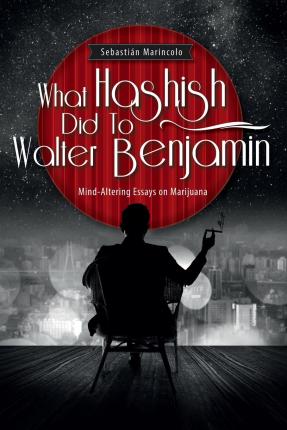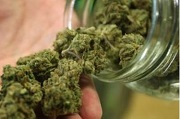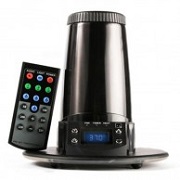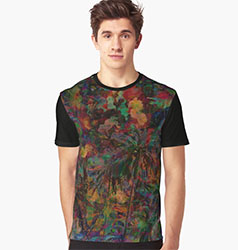Cancer Patient Shares How He Illegally Healed Himself with Medical Pot
Three months ago, an unidentifiedPennsylvania man's story about breaking the law to use medical marijuana went viral. Now, that man has come forward to share his identity, togive an update on his health and to deliver a message to lawmakers....
Marijuana, Escapism, and Mind Traveling
Escapism We all need to escape from our daily routines once in a while. We go on vacations, play tennis, or relax sipping on a glass of wine. Many marijuana users focus on the here-and-now to forget about their daily routines and worries during a high. There is nothing wrong with those little escapes – as long as they help to lead a happy life.
„Is this not the true romantic feeling; not to desire to escape life, but to prevent life from escaping you.“
Thomas Wolfe
We all need to escape from our daily routines once in a while. We go on vacations, play tennis, or relax sipping on a glass of wine. Many marijuana users focus on the here-and-now to forget about their daily routines and worries during a high. There is nothing wrong with those little escapes – as long as they help to lead a happy life.
From Little Escapes to Escapism
For many, however, marijuana has become a means to repeatedly escape from stressful situations and to hide from challenges in their lives. They have moved from their little escapes to an unhealthy pattern of escapism. Of course, the use of marijuana is only one of the many means which can be abused for an escapist stance towards life. Alcohol or activities such as playing a computer game or watching television can be likewise abused for the same purpose.
Marijuana certainly has a great potential to relieve stress, both physiologically as well as psychologically speaking. As to the latter, many who are mainly seeking the stress relief effect of marijuana settle for being “dazed and confused”. To achieve this state of mind, they tend to consume cheap low-quality marijuana which has been harvested too late and stored in the wrong way – exposed to light, oxygen and warm temperatures. A bigger proportion of the THC has then degraded to CBN (cannabinol), which generates a more sedative and confusing state of mind.
Those users want to get more “stoned” than being “high”. This bad quality and the resulting effects are all that many consumers can afford on the black market anyway. The resulting altered state of mind delivers the desired relaxation and the mental escape; on the other hand, however, these users do not fully experience the wide range of cognitive enhancements which good marijuana can potentially generate under favorable conditions.
Prohibition and Escapism
We need to understand that decades of prohibition have actually led to this widespread abuse of marijuana solely for the “dazed-and-confused” effect described above – in various ways. About 40 years ago growers started to use an Afghani indica strain (or, “broad leaf” – cannabis variety) to generate hybrid cannabis strains with a more compact shape, high THC-content and short harvest cycles. They created cannabis plants for growers who wanted a bigger yield, smaller plants to be grown indoors, and a high ration of THC for a better “punch”. As a result, cannabis plants – even the landraces growing in the wild – have changed worldwide and most strains today contain significant levels of the sedative terpene myrcene – a genetic heritage of the Afghan genetics mentioned above.[1]
Also, the prohibition has hindered a free flow of information between users, producers, and scientists. The market is not transparent and users are often completely uneducated about what they consume, so many of them end up getting bad quality and often even laced marijuana. Many users have never experienced the full range of the mind-altering potential of marijuana. And, of course, the prohibition has generated a widespread desire for more escapism. During a prohibition, those who develop a problematic relationship with marijuana are not only left alone by society, but are also criminalized. Many users then react to more trouble with more escapism, using more bad marijuana – they go in a downward spiral.
And, of course, the prohibition has generated a widespread desire for more escapism. During a prohibition, those who develop a problematic relationship with marijuana are not only left alone by society, but are also criminalized. Many users then react to more trouble with more escapism, using more bad marijuana – they go in a downward spiral.
To conclude, then, prohibition has obviously played and still plays a decisive role in influencing an unhealthy dynamic system of growers and users, a system leading to an impoverished use and often a misuse of bad quality marijuana to simply sedate and to daze and confuse users seeking to escape from their every-day worries.
Mind-Travelling Instead of Escaping
In a legalized and regulated market as we can see it now in some parts of the U.S., in the Netherlands, or in Uruguay, we can observe that many users know much more about their strains. They have access to a better quality of marijuana and they can afford a much better quality for their money. Many users do not only get to know countless medical uses of marijuana, but also rediscover and explore the many dimensions of a marijuana high for inspirational and other uses.
I have argued in several places places that if used with skills and knowledge, the marijuana high can bring a whole bouquet of perceptual and cognitive enhancements: a hyperfocus of attention, intensified sensory experiences, as well as the enhancement of episodic memory, imagination, pattern recognition, creativity, introspection, empathic understanding, and insights.[2]
Instead of using marijuana solely for the purpose of relaxation, to stimulate appetite, or to enjoy the euphoria of a high, users start to mind-travel on marijuana and to use these enhancements to compose music, to get creative in the kitchen, to come to a better understanding of their friends, to generate scientific or personal insights, or to make love. They are not going around in circles anymore like many escapists, but instead use marijuana productively to mind-travel and to personally grow. These users describe marijuana as a huge enhancement in their lives.
The stereotype of the lazy, dysfunctional stoner, then, is not misleading and wrong in the sense that this type of users would not exist. They do exist, and there are way too many consumers who abuse marijuana for escapism. However, it is not an intrinsic property of marijuana to automatically produce this dysfunctional state. The problem is generated to a large degree by the prohibition leading to various conditions leading to this widespread abuse and to the consumption of bad marijuana. Also, the problem is generated by a socially cold, materialist neo-liberal society in which many constantly experience too much negative stress, causing them to look for tools to escape.
Legalization, Education, Use and Abuse
Do more people use more marijuana when it is legal to do so? We know from many comparative studies about this subject that this is not necessarily the case.[3] However, I believe that it is time to ask a more relevant question: if we legalize marijuana and educate the public better, will we manage to get less people to abuse marijuana like many do so for escapism? We have every reason to believe so. As we can clearly see now in some parts of the U.S., medical marijuana users with a whole range of indications profit immensely from various cannabis strains developed for their special needs. All consumers now have a transparent market, they know what they buy and they get a much better quality of marijuana for their money. They have a better access to knowledge about how to best use marijuana, about the real risks and its potential. They can more freely experiment with marijuana to find out how they can use it for their own purposes. These are necessary conditions for users to become connoisseurs; and only skills and knowledge will lead them to a more meaningful relation with marijuana.
Maybe we should not worry that much about the total number of marijuana consumers and worry more about the number of unhappy people.
[1] See Michael Backes (2014), Cannabis Pharmacy. The Practical Guide to Medical Marijuana, Black Dog & Leventhal Publishers, New York.
[2] See Sebastian Marincolo (2015), What Hashish Did To Walter Benjamin – Mind-Altering Essays on Marijuana, Khargala Press, Stuttgart.
[3] For a good overview of some studies on that subject matter see http://norml.org/aboutmarijuana/item/marijuana-decriminalization-its-impact-on-use-2.
First publish at http://sensiseeds.com/en/blog/marijuana-escapism-and-mind-traveling/
Pair who claim to supply medicinal cannabis to ill children ‘shattered’ after police raid their home
Medicinal cannabis suppliers Heather Gladman, 59, and Liam Hotham, 27, have been charged after police raided their property near Sale in East Gippsland.
A PAIR who claim to supply medicinal cannabis to dozens of chronically ill children and adults have been charged with cultivating cannabis following a police raid in East Gippsland.
Heather Gladman, 58, and Liam Hotham, 27, have been part of the long fight to legalise medical marijuana across the state and say they are “shattered” by the criminal charges.
Police swooped on their Bradleys Rd property in Stradbroke, near Sale, where they live in separate dwellings, just after 9am Thursday, seizing about 70 plants.
One of the plants was from a seedling a Victorian family sourced from Canada which was meant to specifically help their eight-year-old son who has an inoperable brain tumour.
“The quality of life of those who we supply to is now in danger,” Ms Gladman said.
“I am not a criminal. I’m trying to help these families. I don’t charge them anything. You can't put a price on a life.”
The latest charges also come in the same month Victorian couple Matthew and Elizabeth Pallet were committed to stand trial in the County Court over similar alleged offences.
The Pallets, along with Mr Hotham and Ms Gladman, have all said they will fight the charges.
When asked if the charges would stop her growing, Ms Gladman said: “Not on your life. I’m going home to plant more seeds.
“I am going to fight this until I drop. I’m nearly 60 years old and I want the laws to change before I die.”
In October, the Andrews Government announced it would move to legalise access to locally-manufactured medicinal cannabis, particularly for children with cancer or epilepsy, as early as 2017.
Government-backed cannabis cultivation trials are also taking place this year at a secret location in Melbourne.
Mr Hotham called on Premier Daniel Andrews for an amnesty for those already using the products while legislation is being considered.
“It’s about time we get amnesty,” he said.
“We’re known for being so caring and compassionate for what we do so we are just shattered.
“When it’s kept a boy with an inoperable brain tumour alive and people have said to me it’s the first time in eight years they haven’t felt pain, it brings tears to my eyes we won’t be able to supply it to them in the immediate future.”
Ms Gladman and Mr Hotham both admitted they had first hand experience on the positive effects of medical marijuana.
A spokeswoman for Mr Andrews would not comment on the recent charges.
“The Government has introduced legislation to the parliament and will make good on its promise to legalise medicinal cannabis, because no parent should ever have to choose between their child’s quality of life and breaking the law,” she said.
“It’s important to consider that these laws will not be retrospective, and it is still an offence to grow or supply medical cannabis.”
Ms Gladman and Mr Hotham will appear at Sale Magistrates Court on March 15.
This email address is being protected from spambots. You need JavaScript enabled to view it.
reference:http://www.heraldsun.com.au/news/law-order/pair-who-claim-to-supply-medicinal-cannabis-to-ill-children-shattered-after-police-raid-their-home/news-story/4b53718ca4254a0c5094dabc2f1d18e7
To Vape, or not to Vape, Vaporising is the question
As various legalisation models for cannabis are being proposed and implemented in different parts of the world different ways to consume the plant are also becoming more popular. The 3 main ways to use cannabis are smoking, vaporising and eating (though suppositories, topical applications and even vaginal insertions for women often used for medical applications of cannabis oil).
The primary difference that both smoking and vaporising has compared to eating is the route it takes through your body. While eating cannabis involves cannabinoids going through your digestive system and through your liver. Because of this eating cannabis takes between 40 minutes and 2 hours (depending on other factors) to exert psychoactive effects, which makes titrating doses very difficult.
In contrast to this smoking and vaporising delivers cannabis to the brain very quickly, with in seconds, as cannabinoids are absorbed through the lungs and then sent directly to the brain via the heart.
Eating cannabis may be preferable for treating serious illnesses, like cancer, because it allows larger doses to saturate the entire body, as opposed to concentrating doses in the brain, and suppositories are becoming more popular for a similar reason (with a superior absorption rate observed through suppositories compared to oral ingestion, along with other advantages which include lower psychoactive effects which is largely due to the fact that suppositories generally by pass the liver where Delta 9 THC is converted into the more psychoactive 11 Hydroxyl THC).
But while eating cannabis (or even better using suppositories) may be the more effective way to saturate the body with cannabinoids, which is desired for treating many conditions long term, it is not so ideal when using cannabis to treat symptoms, largely because the effects are so delayed and doses very hard to titrate as a result.
So for people who need immediate relief the delivery of cannabinoids through the lungs, experienced when smoking or vaporising, allows almost immediate relief as the cannabinoids reach the brain within seconds, as opposed to the 40 minutes to 2 hours that is often required when ingesting cannabis orally.
This allows doses to be titrated with tremendous precision and users are able to experience immediate relief for treating various symptoms. For recreational users these immediate effects are also very desirable as is the dose precision facilitated.
While smoking and vaporising are similar to each other in respect to the delivery method and the resulting advantages of providing immediate effects, there are some very significant advantages that vaporising has over smoking.
Probably the most obvious differences between smoking and vaporising is the health advantages of vaporising cannabis. Although smoking cannabis does not expose users to the same health risks as tobacco smoking it does still expose the lungs to smoke and inhaling combusted plant matter does involve the consumption of harmful chemicals, including recognised carcinogens. The largest study conducted on smoking cannabis has shown that not only does cannabis smoking not represent an increased risk of cancer, despite the presence of carcinogens, but the study suggested that smoking cannabis actually reduced the risk of developing head, neck and lung cancers with cannabis smokers less likely to develop cancer than even non smokers. The likely reason for these seemingly contradictory results is the cancer killing properties of cannabinoids like THC, that likely offsets and negates any carcinogenic effects of the smoke present.
http://www.scientificamerican.com/article/large-study-finds-no-link/
Despite the lack of established cancer risk from smoking cannabis, along with a failure to establish other health risks, the fact remains that cannabis smoke, particularly when smoking herbal forms of cannabis (as opposed to "dabbing" oils or similar extracts) does contain many potentially harmful chemicals.
The health advantages of vaporising cannabis, compared to smoking, is primarily the absence of these harmful chemicals as combustion is either avoided or drastically limited when cannabis is vaporised. This allows user to consume vaporised cannabinoids with out the harmful by products associated with smoke.
Both smoking and vaporising cannabis involves the inhalation of vaporised cannabinoids, but smokers are also inhaling a cocktail of potentially harmful chemicals in amongst the vaporised cannabinoids and while the presence of the cannabinoids does appear to offset some of the potential harm caused by the smoke the health advantages of consuming these cannabinoids without the inclusion of smoke is obvious.
In addition to the health advantages there is also other advantages that vaporising has over smoking.
Vaporising cannabis provides a far greater yield of both cannabinoids and the terpenes which have shown tremendous synergistic effects, as well as standalone benefits, including but not limited to anti inflammatory properties.
http://www.ncbi.nlm.nih.gov/pubmed/21749363
This increased yield is largely down to the fact that smoking cannabis actually destroys a significant percentage of the terpenes and cannabinoids as they are combusted, rather than vaporised, leaving the user to inhale a mixture of vaporised cannabinoids and harmful by products of combustion, where as vaporising essentially provides vaporised cannabinoids with little to no combustion involved. So rather than wasting cannabinoids as so many are combusted and lost, vaporised cannabinoids provides a significantly larger yield, making vaporising a far more efficient, and as a result more economical, method of consuming cannabis than the comparatively wasteful method of smoking.
http://www.canorml.org/healthfacts/Second-Study-Shows-Vaporizers-Drastically-Reduce-Toxins-in-Marijuana-Smoke
Studies on vaporising cannabis has shown the potential for vaporising to reverse conditions caused by smoking
http://www.ncbi.nlm.nih.gov/pubmed/20451365
With patients largely preferring natural cannabis to pharmaceutical drugs that are cannabis based (usually involving synthetic cannabinoids, rather than naturally occurring cannabinoids) and studies demonstrating a far greater efficacy from natural cannabinoids, as well as the superior efficacy associated with naturally occurring combinations of cannabinoids, which is known as the entourage effect, where a combination of naturally occurring cannabinoids appears to produce benefits far better than isolated cannabinoids, essentially demonstrating that cannabinoid combinations, as found naturally in cannabis, are greater than the sum of their parts.
http://www.tandfonline.com/doi/abs/10.1080/02791072.2013.805976
http://www.leafscience.com/2013/11/04/patients-find-cannabis-effective-cannabis-pharmaceuticals/
The advantages of vaporising cannabis, along with the medicinal value of natural cannabis in general, are so well established that vaporising cannabis is considered to be both a safe and healthy, as well as an effective, method of consuming the plant. With Israel appearing to lead the way both in regards to the use of natural cannabis medicines and in particular the applications of vaporising as the delivery method.
http://cms.herbalgram.org/herbalgram/issue97/hg97-featcannabis.html?ts=1384026817&signature=3715c09369e4572cc7264013cdce4393&ts=1454852928&signature=07094e28941b24a505c139202ffefeac
While standard vaporisers generally provide the basic benefits of vaporising and possess the advantages over smoking (primarily providing vaporised cannabinoids with out the harmful by products associated with combustion) the more sophisticated vaporisers allow for even more precision when it comes to cannabinoid consumption.
Because cannabinoids, and terpenes, vaporise at different temperatures the ability to control the exact temperature, a feature more common among the more sophisticated vaporisers, allow users to provide a more specific dose of certain cannabinoids with many patients reporting preferable effects from certain temperature ranges.
Generally speaking the primary difference between basic vaporisers and more sophisticated ones is the difference between conduction and convection. Conduction involving simply heating the cannabis using a hot surface where the cannabis in contact with the surface is often exposed to higher temperatures. Convection on the other hand is able to provide more consistent and precise temperatures as vaporisers using this method will heat the cannabis through a medium like hot air, which allows for better temperature control and a more even distribution of the heat applied.
Though it cannot be denied that many cannabis users prefer the taste and effects of smoked cannabis to vaporised cannabis, though many users will make the exact opposite claim, generally speaking vaporising has numerous advantages over smoking while smoking has virtually no advantages over vaporising.
Vaporising cannabis is more healthy and more economical (at least in the in the long run) and provides far greater yields of both the cannabinoids and the terpenes present. The effects are different with many patients who use cannabis for medicinal purposes, as oppose to recreational use, reporting that they experience a more clear headed high from vaporising, where as smoking cannabis is described as more narcotic like in the experience it provides.
Innovations like dabbing cannabis oil, for example, do negate some of the potential harms associated with smoking (as the lack of plant material in cannabis oil equates to a lack of tar in the smoke and makes the experience more akin to vaporising, the issue of combusting, and hence losing, a large percentage of cannabinoids from the heat involved in smoking cannabis the most efficient way to consume cannabis with out wasting cannabinoids and with out consuming harmful chemicals is clearly vaporising and as a result vaporising cannabis is considered the optimal way to consume cannabis through the lungs, especially when used for medicinal applications. With the increased yield also making it preferable for many recreational users.
By Matt Sands
Medical Cannabis Educator
Latest
Coronavirus Strikes Massachusetts Cannabis Company Employees
Reassessing the Essential: Cannabis in the Time of a Pandemic
5 Reasons To Try Aspen Valley CBG Flower (30% Off)
High Times Cannabis Cups Go Virtual In Wake Of Coronavirus Pandemic
Drug Enforcement Administration Proposes Plan To Expand Cannabis Research
Ghana Legalizes Cannabis For Medicinal And Industrial Uses
The cheapest legal weed in Canada: Discover these cannabis ‘value brands’
Cannabis and coronavirus: Here’s what you need to know
cannabis designs
The Best Of
WHO Rules CBD Should Not Be a Scheduled Drug

Dr Cristina Sanchez PhD video interview on medical marijuana and cancer

Biochemist Dennis Hill interview; Cannabis oil as a cure for cancer.

The unofficial World Record holder for cannabis smoking part 1








